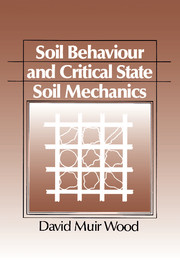Book contents
- Frontmatter
- Dedication
- Contents
- Preface
- Acknowledgements
- List of symbols
- 1 Introduction: models and soil mechanics
- 2 Elasticity
- 3 Plasticity and yielding
- 4 Elastic-plastic model for soil
- 5 A particular elastic—plastic model: Cam clay
- 6 Critical states
- 7 Strength of soils
- 8 Stress—dilatancy
- 9 Index properties
- 10 Stress paths and soil tests
- 11 Applications of elastic—plastic models
- 12 Beyond the simple models
- References
- Index
1 - Introduction: models and soil mechanics
Published online by Cambridge University Press: 05 October 2014
- Frontmatter
- Dedication
- Contents
- Preface
- Acknowledgements
- List of symbols
- 1 Introduction: models and soil mechanics
- 2 Elasticity
- 3 Plasticity and yielding
- 4 Elastic-plastic model for soil
- 5 A particular elastic—plastic model: Cam clay
- 6 Critical states
- 7 Strength of soils
- 8 Stress—dilatancy
- 9 Index properties
- 10 Stress paths and soil tests
- 11 Applications of elastic—plastic models
- 12 Beyond the simple models
- References
- Index
Summary
Use of models in engineering
Scientific understanding proceeds by way of constructing and analysing models of the segments or aspects of reality under study. The purpose of these models is not to give a mirror image of reality, not to include all its elements in their exact sizes and proportions, but rather to single out and make available for intensive investigation those elements which are decisive. We abstract from non-essentials, we blot out the unimportant to get an unobstructed view of the important, we magnify in order to improve the range and accuracy of our observation. A model is, and must be, unrealistic in the sense in which the word is most commonly used. Nevertheless, and in a sense, paradoxically, if it is a good model it provides the key to understanding reality. (Baran and Sweezy, 1968)
Engineering is concerned with understanding, analysing, and predicting the way in which real devices, structures, and pieces of equipment will behave in use. It is rarely possible to perform an analysis in which full knowledge of the object being analysed permits a complete and accurate description of the object to be incorporated in the analysis. This is particularly true for geotechnical engineering. The soil conditions under a foundation or embankment can be discovered only at discrete locations by retrieving samples of soil from boreholes or performing in situ tests; soil conditions between such discrete locations can be deduced only by informed interpolation.
- Type
- Chapter
- Information
- Soil Behaviour and Critical State Soil Mechanics , pp. 1 - 36Publisher: Cambridge University PressPrint publication year: 1991



